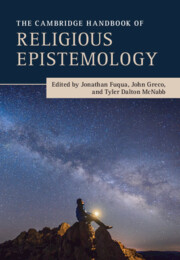83 results
Copyright page
-
- Book:
- The Cambridge Handbook of Religious Epistemology
- Published online:
- 24 August 2023
- Print publication:
- 17 August 2023, pp iv-iv
-
- Chapter
- Export citation
References
-
- Book:
- The Cambridge Handbook of Religious Epistemology
- Published online:
- 24 August 2023
- Print publication:
- 17 August 2023, pp 305-334
-
- Chapter
- Export citation
Tables
-
- Book:
- The Cambridge Handbook of Religious Epistemology
- Published online:
- 24 August 2023
- Print publication:
- 17 August 2023, pp vii-viii
-
- Chapter
- Export citation
Part III - New Directions
-
- Book:
- The Cambridge Handbook of Religious Epistemology
- Published online:
- 24 August 2023
- Print publication:
- 17 August 2023, pp 191-304
-
- Chapter
- Export citation
Contributors
-
- Book:
- The Cambridge Handbook of Religious Epistemology
- Published online:
- 24 August 2023
- Print publication:
- 17 August 2023, pp ix-x
-
- Chapter
- Export citation
Part I - Faith and Rationality
-
- Book:
- The Cambridge Handbook of Religious Epistemology
- Published online:
- 24 August 2023
- Print publication:
- 17 August 2023, pp 11-114
-
- Chapter
- Export citation
Contents
-
- Book:
- The Cambridge Handbook of Religious Epistemology
- Published online:
- 24 August 2023
- Print publication:
- 17 August 2023, pp v-vi
-
- Chapter
- Export citation
Part II - Religious Traditions
-
- Book:
- The Cambridge Handbook of Religious Epistemology
- Published online:
- 24 August 2023
- Print publication:
- 17 August 2023, pp 115-190
-
- Chapter
- Export citation
Index
-
- Book:
- The Cambridge Handbook of Religious Epistemology
- Published online:
- 24 August 2023
- Print publication:
- 17 August 2023, pp 335-338
-
- Chapter
- Export citation

The Cambridge Handbook of Religious Epistemology
-
- Published online:
- 24 August 2023
- Print publication:
- 17 August 2023
Alternative metrics for characterizing longer-term clinical outcomes in difficult-to-treat depression: I. Association with change in quality of life
-
- Journal:
- Psychological Medicine / Volume 53 / Issue 14 / October 2023
- Published online by Cambridge University Press:
- 05 January 2023, pp. 6511-6523
-
- Article
-
- You have access
- Open access
- HTML
- Export citation
Copyright page
-
- Book:
- The Transmission of Knowledge
- Published online:
- 21 August 2020
- Print publication:
- 27 August 2020, pp iv-iv
-
- Chapter
- Export citation
Acknowledgments
-
- Book:
- The Transmission of Knowledge
- Published online:
- 21 August 2020
- Print publication:
- 27 August 2020, pp x-xii
-
- Chapter
- Export citation
Index
-
- Book:
- The Transmission of Knowledge
- Published online:
- 21 August 2020
- Print publication:
- 27 August 2020, pp 211-214
-
- Chapter
- Export citation
Bibliography
-
- Book:
- The Transmission of Knowledge
- Published online:
- 21 August 2020
- Print publication:
- 27 August 2020, pp 200-210
-
- Chapter
- Export citation
3 - Joint Agency and the Role of Trust in Testimonial Knowledge
-
- Book:
- The Transmission of Knowledge
- Published online:
- 21 August 2020
- Print publication:
- 27 August 2020, pp 47-67
-
- Chapter
- Export citation
9 - Social Religious Epistemology
-
- Book:
- The Transmission of Knowledge
- Published online:
- 21 August 2020
- Print publication:
- 27 August 2020, pp 161-184
-
- Chapter
- Export citation
7 - Education and the Transmission of Understanding
-
- Book:
- The Transmission of Knowledge
- Published online:
- 21 August 2020
- Print publication:
- 27 August 2020, pp 126-144
-
- Chapter
- Export citation
1 - Introduction
-
- Book:
- The Transmission of Knowledge
- Published online:
- 21 August 2020
- Print publication:
- 27 August 2020, pp 1-24
-
- Chapter
- Export citation
Preface
-
- Book:
- The Transmission of Knowledge
- Published online:
- 21 August 2020
- Print publication:
- 27 August 2020, pp vii-ix
-
- Chapter
- Export citation



